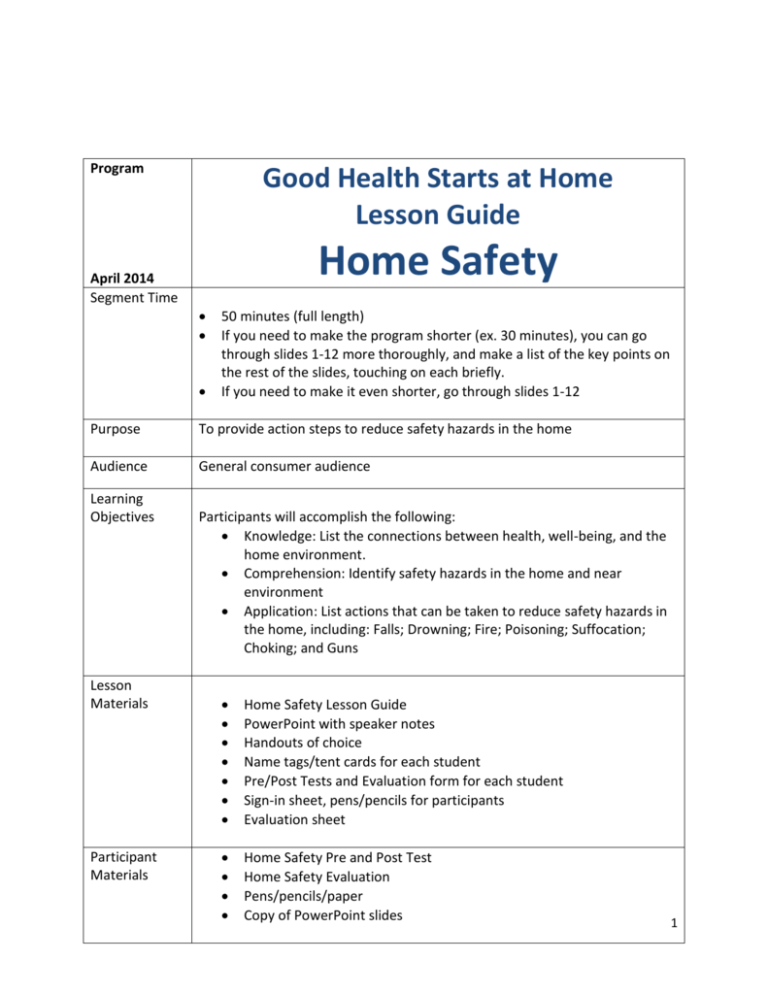Home Safety - Healthy Homes Partnership
advertisement

Program Good Health Starts at Home Lesson Guide Home Safety April 2014 Segment Time 50 minutes (full length) If you need to make the program shorter (ex. 30 minutes), you can go through slides 1-12 more thoroughly, and make a list of the key points on the rest of the slides, touching on each briefly. If you need to make it even shorter, go through slides 1-12 Purpose To provide action steps to reduce safety hazards in the home Audience General consumer audience Learning Objectives Lesson Materials Participant Materials Participants will accomplish the following: Knowledge: List the connections between health, well-being, and the home environment. Comprehension: Identify safety hazards in the home and near environment Application: List actions that can be taken to reduce safety hazards in the home, including: Falls; Drowning; Fire; Poisoning; Suffocation; Choking; and Guns Home Safety Lesson Guide PowerPoint with speaker notes Handouts of choice Name tags/tent cards for each student Pre/Post Tests and Evaluation form for each student Sign-in sheet, pens/pencils for participants Evaluation sheet Home Safety Pre and Post Test Home Safety Evaluation Pens/pencils/paper Copy of PowerPoint slides 1 Equipment 3 helpful websites Laptop LCD Projector Speakers for computer (if showing videos) Extension cord and power strip Microphone (if you are inviting a guest speaker or have a large group) White board or flip chart and markers Internet connection to show videos US Department of Housing and Urban Development (HUD) Healthy homes and lead hazard control: http://www.hud.gov/healthyhomes US Consumer Product Safety Commission (CPSC): http://www.cpsc.gov National Capital Poison Center http://www.poison.org Student Materials (Select most appropriate materials for your audience) Selected Home Safety Checklists Help Yourself to a Healthy Home http://www.aces.edu/pubs/docs/H/HE-0883/HE-0883.pdf focus on chapter on Home Safety Home Safety Factsheet http://portal.hud.gov/hudportal/documents/huddoc?id=ohhlhcflyerh omesafety.pdf (download—2 pages) Your Poison Center Brochure https://aapcc.s3.amazonaws.com/files/library/English_lo_adobe.pdf (also available in several other languages); call to report poisonings 1800-222-1222 Safe Kids USA o www.safekids.org; Look under “Safety Resources By Risk Area” (Choking, Suffocation and Strangulation, Drowning, Water Safety, Falls, Fires and Burns, Poison, etc.) Choose a version that is appropriate to the audience; consider elders, general population, and children. Examples include: For elders: A Housing Safety Checklist for Older People (produced by Sarah Kirby, North Carolina State University) http://www.ces.ncsu.edu/depts/fcs/pdfs/FCS-461.pdf 2 Selected videos Optional Student Materials (Select most appropriate materials for your audience) For general audiences: Home Safety Checklist (produced by Janet Valente, Pamela R. Turner, The University of Georgia) http://www.fcs.uga.edu/ext/housing/pubs/Home_Safety_CheckList.p df For homes with small children living and/or visiting: Home Safety – A Checklist for Families (produced by Mary Yearns and Lesia Oesterreich, Iowa State University) http://www.extension.iastate.edu/publications/pm1621.pdf Home Fire Safety Checklist: http://www.nsc.org/safety_home/HomeandRecreationalSafety/Docu ments/HomeFireSafetyChecklist.pdf US Centers for Disease Control and Prevention (CDC) CDCTV: Health begins at home http://www.cdc.gov/CDCTV/HealthHome/ US CPSC video about crib recalls: http://www.cpsc.gov/Newsroom/Multimedia/?vid=61790 YouTube videos (connection to internet required or download in advance) Optional (additional resources) Home Fire Safety Checklist (National Safety Council) http://www.nsc.org/safety_home/HomeandRecreationalSafety/Docu ments/HomeFireSafetyChecklist.pdf Home Disaster Kit (FEMA) o http://www.ready.gov/basic-disaster-supplies-kit For children: Is Your Home A Healthy Home (Coloring and Activity Book) http://www.aces.edu/pubs/docs/H/HE-0937/HE-0937.pdf Extended Activities Field trip Visit a pre-1978 home undergoing renovation to see lead-safe work practices in action 3 Suggested “show & tell” demonstration tools (select most appropriate materials for your audience) Falls hazards (ex. small throw rugs, toys, shoes); Tape measure (to demonstrate safe distances between pieces of furniture, etc.) Drowning (life vest; pictures of good pool fences; pictures of pools lacking a fence) Fire hazards (smoke alarm; carbon monoxide alarm) Poisoning hazards (cleaning supplies stored under the sink; grandma’s purse/suitcase with medication in it; cabinet door locks; Poison Control information) Suffocation (coins, marbles, buttons; pictures of old refrigerators) Choking (age appropriate toys; toilet paper tube to demonstrate toys that are too small for young children) Guns (picture of a closed, locked gun safe) 4 Preparing for this Lesson Home Safety Preparing for this Session This lesson assumes that an Extension educator will be the facilitator. If an alternate facilitator or co-facilitator is used, be certain they have reviewed the material and are clear that Extension is tasked with presenting non-biased material. Before the meeting: 1. Several weeks in advance: Determine appropriate meeting location and time for the program. Contact an Extension educator or other guest speaker at least a month in advance (optional)—if using, use Guest Speaker form. Send out notices for meeting. Order handouts/reference materials if not making copies. 2. At least one week before training: Read the lesson guide and PowerPoint materials. Add speaker notes if necessary. Review handouts/reference materials and supplemental material carefully. Make copies of handouts for this session. Review the optional activities and assemble show and tell activity/demonstration tools. Visit a retail store and purchase demonstration supplies as needed. See Suggested Materials and Supplies for Demonstrations and Activities. 3. Day before Training Assemble snacks/beverages: water, sodas, crackers, fruit, plates, napkins, etc. 5 Presenting the Lesson Home Safety Presenting the program Segment Time Activity Materials Introductions or getacquainted activity of your choice PowerPoint slides (HYHH) book Introduction What about home safety? 2-5 What do hazards look like? 20 Ask: Has anyone ever been hurt at home? Home assessment 20 Discuss: Briefly discuss some home safety facts PowerPoint slides HYHH book Evaluation 3 Show: Display pictures of PowerPoint slides; hazards; during each segment safety props do a show-and-tell. Show appropriate safety tools and demonstrate how they work. Gina Peek, Oklahoma State University, April 2014 6 Sample news releases and radio spots Healthy Homes Everyone needs a healthy home. However, did you know that some of the most serious health and safety problems may start at home? Did you know that your chances of getting hurt at home are much higher than they are at work or school? Very young children and older adults are the people most likely to get hurt at home. In the U.S., most people spend over 90% of their time indoors. We need to be aware of the health and safety of our indoor environments. There are steps and resources that can help us keep our homes safe. (Agency name) is sponsoring a program at (time) on (date) at (location). This program covers safety in the indoor environment. The program will address hazards such as falls, fire, poisonings, drowning, suffocation, choking and guns. Additional helpful resources will be given. For more information or to register for the program call or email (agency name) at (phone number) or (email address). National Poison Prevention Week (Third week of March) Promote Poison Prevention Week http://www.aapcc.org/prevention/nppw/ Publicize the Poison Help line: 1-800-222-1222. This number links to poison centers in all states 24 hours a day, seven days a week. Download info, graphics, and press releases Fire Prevention Week (Second week of October) Download the tools to promote home fire safety: http://www.nsc.org/safety_home/SafetyObservances/Pages/FirePreventionWeek.aspx?wa& Steps to prevent fires: Have properly working smoke alarms Test smoke alarms and carbon monoxide detectors monthly and change the batteries at least once a year Place smoke alarms on each floor of your home and in each bedroom Plan a family escape route and practice it once a month Install a home sprinkler system Place fire extinguishers throughout your home and make sure everyone in the house knows how to use them 7 Guest Speaker Confirmation Form: Home Safety Speaker: Today’s Date: Presentation Date & Time: Location: Location Directions: # Of Expected Participants: General Audience: Background: The home safety workshop you are speaking at provides consumers with information on actions to take to make our home safer. Your experiences with home safety may help people to understand one or more of the following: poison prevention, fire safety, falls around the home, choking and suffocation hazards, drowning hazards, etc. Please share information that will help those with tools to have safer homes. Thank you language: Other info: Please let the workshop coordinator know of any audiovisual equipment or other needs you might have at least 2 business days prior to the presentation. Home safety workshop coordinator contact info: Thank you for agreeing to share your expertise on Home Safety. 8






